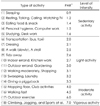1. Oh K, Jang MJ, Lee NY, Moon JS, Lee CG, Yoo MH, Kim YT. Prevalence and trends in obesity among Korean children and adolescents in 1997 and 2005. Korean J Pediatr. 2008. 51(9):950–955.

2. Ministry of Health and Welfare. Korea Health Statistics 2010: Korea National Health and Nutrition Examination Survey (KNHANES V-1). 2011.
3. Ebbeling CB, Pawlak DB, Ludwig DS. Childhood obesity: public-health crisis, common sense cure. Lancet. 2002. 360(9331):473–482.

4. Choi TI, Rhee HJ, Ko KM, Yoo SM, Kim KN, Lee SY, Kang JH. The prevalence of obesity and obesity-related metabolic complications in Korean adolescents. J Korean Acad Fam Med. 2006. 27(3):175–181.
5. Barlow SE. Expert Committee. Pediatrics. Expert committee recommendations regarding the prevention, assessment, and treatment of child and adolescent overweight and obesity: summary report. Pediatrics. 2007. 120:Suppl 4. S164–S192.
6. Seo JW. Obesity in children and adolescents. Korean J Pediatr. 2009. 52(12):1311–1320.

7. Lee HM, Kim EK. Assessment of daily steps, physical activity and activity coefficient of the elementary school children in the rural area. Korean J Community Nutr. 2007. 12(3):361–371.
8. Baek S. The effect of physical activity on children's obesity. Korean J Obes. 2008. 17(2):55–64.
9. Owen OE, Kavle E, Owen RS, Polansky M, Caprio S, Mozzoli MA, Kendrick ZV, Bushman MC, Boden G. A reappraisal of caloric requirements in healthy women. Am J Clin Nutr. 1986. 44(1):1–19.

10. An YD. A study on physical activity for one week in elementary school boys. J Korea Sport Res. 2007. 18(2):545–556.
11. Kim YS, Kong SA, Lee O, Kim JW, Kim SS, Park IH. The relation between physical activity and fitness in children. Exerc Sci. 2008. 17(4):495–504.

12. Woo UH. Comparison and analysis of physical activity steps per day according to the level of BMI in high school male students. Korean J Growth Dev. 2008. 16(2):103–110.
13. Kang HS, Hong HR, Park JK. Comparison of obesity indices, metabolic risk factors, physical activity between boys and girls. Korean J Phys Educ. 2010. 49(6):581–589.
14. Koo JC, Park MH. The correlation between body composition and basic physical strength of high school students by bioelectrical impedance analysis. J Learn Cent Curric Instr. 2010. 10(2):35–48.
15. Jung JU, Hwang YS, Oh SI. Analysis of elementary school students' physical activity based on existence of playground and physical education. J Korean Soc Study Phys Educ. 2010. 15(1):301–310.
16. Energy and protein requirements. Report of a joint FAO/WHO/UNU Expert Consultation. World Health Organ Tech Rep Ser. 1985. 724:1–206.
17. The Korean Nutrition Society. Dietary reference intakes for Koreans. 2010. 1st revision. Seoul:
18. Kim JH, Kim EK. Assessment of physical activity, activity coefficient of preschool children and actual condition of daycare center outdoor play. Korean J Community Nutr. 2009. 14(6):777–788.
19. Kim EK, Kim EK, Song JM, Choi HJ, Lee GH. Assessment of activity coefficient, resting energy expenditure and daily energy expenditure in elementary school children. J Korean Diet Assoc. 2006. 12(1):44–54.
20. Oh SI, Jang JH, Hur S. Assessment of after-school obesity control program through on life habits and physical activity in obese elementary school children. Korean J Exerc Nutr. 2008. 12(1):1–6.
21. Kim MJ, Na HJ, Kim Y. The analysis of activity energy, total energy, and estimated energy expenditures in 5th and 6th grade primary school students. Korean J Community Nutr. 2011. 16(2):195–205.

22. Kim Y, Na HJ. The estimation of the daily energy expenditure of Korean adolescents. Korean J Community Nutr. 2003. 8(3):270–279.
23. Kim EK, Kim GS, Park JS. Comparison of activity factor, predicted resting metabolic rate, and intakes of energy and nutrients between athletic and non-athletic high school students. J Korean Diet Assoc. 2009. 15(1):52–68.
24. Choi HJ, Song JM, Kim EK. Assessment of daily steps, activity coefficient, body composition, resting energy expenditure and daily energy expenditure in female university students. J Korean Diet Assoc. 2005. 11(2):159–169.
25. Park JA, Kim KJ, Yoon JS. A comparison of energy intake and energy expenditure in normal-weight and over-weight Korean adults. Korean J Community Nutr. 2004. 9(3):285–291.
26. Korea Centers for Disease Control and Prevention. The Korean Pediatric Society. The Committee for the Development of Growth Standard for Korean Children and Adolescents. 2007 Korean children and adolescents growth charts. 2007. cited 2012 Jun 15. Available from:
http://www.cdc.go.kr.
27. Ministry of Health, Labour and Welfare. Japanese dietary allowance. 1985. 5th revision. Tokyo:
28. Ministry of Health and Welfare. A study to determine the recommended dietary allowance of energy and to develop practical dietary education program for Korean adults. 2002. Seoul:
29. Compher C, Frankenfield D, Keim N, Roth-Yousey L. Evidence Analysis Working Group. Best practice methods to apply to measurement of resting metabolic rate in adults: a systematic review. J Am Diet Assoc. 2006. 106(6):881–903.

30. Weir JB. New methods for calculating metabolic rate with special reference to protein metabolism. J Physiol. 1949. 109(1-2):1–9.

31. Bland JM, Altman DG. Statistical methods for assessing agreement between two methods of clinical measurement. Lancet. 1986. 1(8476):307–310.

32. Baik I, Shin C. Association of daily sleep duration with obesity, macronutrient intake, and physical activity. Korean J Community Nutr. 2011. 16(3):315–323.

33. Rey-López JP, Vicente-Rodríguez G, Biosca M, Moreno LA. Sedentary behaviour and obesity development in children and adolescents. Nutr Metab Cardiovasc Dis. 2008. 18(3):242–251.

34. Mifflin MD, St Jeor ST, Hill LA, Scott BJ, Daugherty SA, Koh YO. A new predictive equation for resting energy expenditure in healthy individuals. Am J Clin Nutr. 1990. 51(2):241–247.

35. Institute of Medicine of the National Academies. Dietary reference intakes for energy, carbohydrate, fiber, fat, fatty acids, cholesterol, protein, and amino acids. 2002. Washington D.C: The National Academies Press;107–264.
36. Wang X, You T, Lenchik L, Nicklas BJ. Resting energy expenditure changes with weight loss: racial differences. Obesity (Silver Spring). 2010. 18(1):86–91.








 PDF
PDF ePub
ePub Citation
Citation Print
Print







 XML Download
XML Download